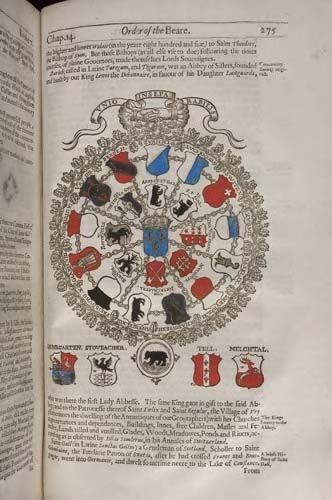Favyn, André
The theater of honour and knight-hood
£850
Auction: 8 February 2006 at 11:00 GMT
Description
The theater of honour and knight-hood or a compendious chronicle and historie of the whole Christian world containing the original of all monarches, kingdomes, and estates, with their emperours, kings, princes and governours ... the first institution of armes, emblazons, kings, heralds, and pursuivants of armes. London: William Jaggard, 1623. First edition in English, 2 parts in 1 volume, folio, title-page in red and black, with 5 (of 12) engraved plates of arms duplicated in the text of the book, numerous woodcut illustrations of orders, arms, etc. in the text of which the illustration of the Order of the Bear on p. 275 of the second volume and eight coats of arms at the end have been hand coloured, modern half calf, marbled boards, endpapers renewed, edges of title-page a little worn, wormhole at lower inner margin through a few signatures.
Note: Moule 111; STC 10717. First published in Paris in 1620, the work "comprises the most valuable treatise we have in English upon the Foreign orders of knighthood; there are other discussions upon the Ceremonies, Combats, Precedence &c. equally worth the attention of the antiquary and historian." (Moule)
The work has an additional significance, in that its execution took place alongside the production of the Shakespeare first folio and, therefore, plays an important part in studying its production and printing. The Theater was entered in the Stationers' Register on 23 October 1622, but printing probably began in February-March 1622 at the same time as work began on the Shakespeare Folio, and that it was finished at the sane time as F1. The Theater shares not only the same format with the First Folio, but certain ornaments and rules, in particular the "Satyr" ornament. The different states of the types and ornaments in both F1 and the Theater are an important guide to the printing of the First Folio. (see Hinmann Printing and proof-reading of the First Folio Shakespeare, p. 36, etc.) For example, Peter Blaney (The First Folio), records an F1 page which has picked up a distinct image from the press's tympan, of an engraving used in the Theater.

